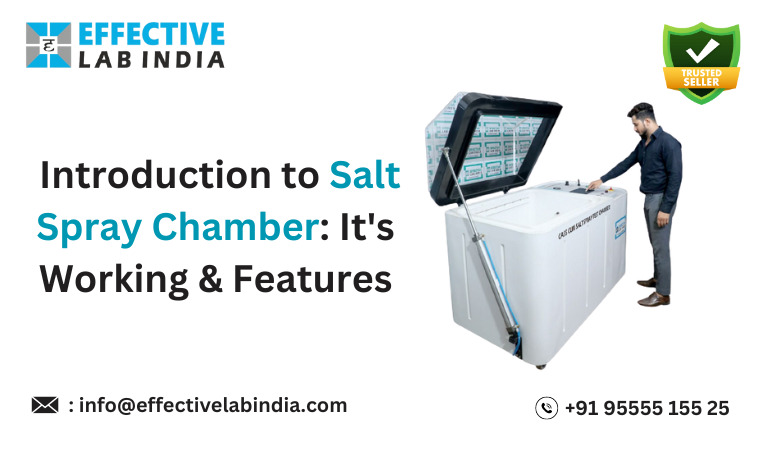
Effective Lab’s salt spray chamber checks the corrosion resistance of paint, powder-coated, and plated items. Salt spray testing determines the lifespan of paint, coating, and plating, including but not limited to powder coating, zinc plating, nickel and chrome plating, CED coating, phosphate surfaces, alloy plating, electroplated chromium, copper, and tin. Among the numerous manufacturers of salt spray chambers is Effective Lab India—our lab-testing corrosion chamber.
The Salt Spray Test Chamber is designed specifically based on standards such as ASTM B117, JIS Z 2371, ISO 9227, and ASTM G85, among others. We establish a saline-like atmosphere inside it using compressed air and a salt solution. The mixture will consist of 95 parts DM water and 5 parts NACL (98% lab grade). This salt spray test chamber applies to different industries like aerospace, metals, and automotive. People can test an item by subjecting it to an environmental chamber test. Cryptography uses a keyed variable permutation in place of a block cipher’s fixed or non-changing permutation, so producers can simply verify the durability of their products.
Working Principle of Salt Spray Chambers
A salt spray chamber operates by providing an ideal condition for spraying a saline solution on test samples in the form of droplets. A series of operations are usually involved in this process:
- A saline solution is made by mixing water with a certain amount of salt, often sodium chloride.
- Atomization: A system of nozzles atomizes the saline solution to create a fine mist or fog.
- Exposure: The salt spray tests samples inside the chamber, with the exposure time depending on test needs.
- Monitoring: The chamber’s conditions, such as temperature, humidity, and spray volume, are always checked to ensure uniformity.
- Evaluation: After the examination period, samples are tested for corrosion signs such as rust, blisters, or other types of degradation.
Features of Salt Spray Chambers from Effective Lab India
Effective Lab India has developed chambers that use salt spray. Some of the features of the chambers are:
- Durable Construction: Chambers that ensure longevity and reliability are made of materials that cannot corrode.
- Precise Control Systems: Sophisticated control systems enable precise monitoring of temperature, humidity and spray volume.
- Uniform Spray Distribution: The saline mist is uniformly distributed by specially designed spray nozzles to ensure consistent test conditions.
- Easy Operation: Operating and monitoring chambers is made easy by user-friendly interfaces and automated systems.
- Compliance with Standards: The chambers meet international standards like ASTM B117. This guarantees that the test results will be recognized globally.
- Safety Features: To ensure safe operation this product is equipped with features like over-temperature protection and an automatic shut-off.
Following are Some Features of the Salt Spray Test Chamber
- To avoid SS overflow, the structure is impenetrable.
- It sports saline as well and uses a tower spraying scheme.
- The corrosion testing work room temperature, with RT +5°C as
- The lower bound to 50°C in the chamber and 40°C – 63°C for the saturated barrel.
- It is 0 – 99,999 m when testing SS.
- The spray means are AASS, NSS, and CASS.
The temperature of the test in the Corrosion test chamber can be changed to +40C and is governed by a control system referred to as PID.
The Salt Spray Chamber tests the corrosion resistant of paints and gives a reliable result always. It is therefore used to establish the strength of products against weather elements.
When running this test, it is important to monitor and collect data continuously. The temperature, humidity and salt concentration are monitored and recorded by the chamber respectively for maintaining uniform conditions and this information can be useful for understanding the corrosion resistance of the samples.
Key Features
High-quality materials including fiberglass, stainless steel, or PVC are used to build salt spray chambers designed to withstand the harsh testing environment and are abrasion-resistant.
Modern salt spray test chambers these days are automated with advanced control systems that enable users to program and monitor test conditions easily. Therefore, touchscreen interfaces and the ability to log data are things you will easily find on them.
A uniform Spray Distribution will ascertain that salt mists are spread evenly so that testing remains perfect. To achieve this evenness in the chambers, they have been fitted with nozzles and air flow systems with exactness.
The large and transparent viewing windows are designed to provide a clear view of test samples without the need to open the chamber, thereby interrupting the test conditions, with a great number of chambers having been built from corrosion-resistant materials to enhance their durability.
Safety is of paramount importance in any test environment, with salt spray chambers equipped with safety measures including excess temperature protection, emergency stop buttons and alerts for any problems detected.
The salt spray test machines are meant to comply with different global standards which include the ASTM B117, ISO 9227 and JIS Z 2371 to make them dependable and accurate for use. This way customers will be able to have comparable test results from one lab to another regardless of their nature or position.